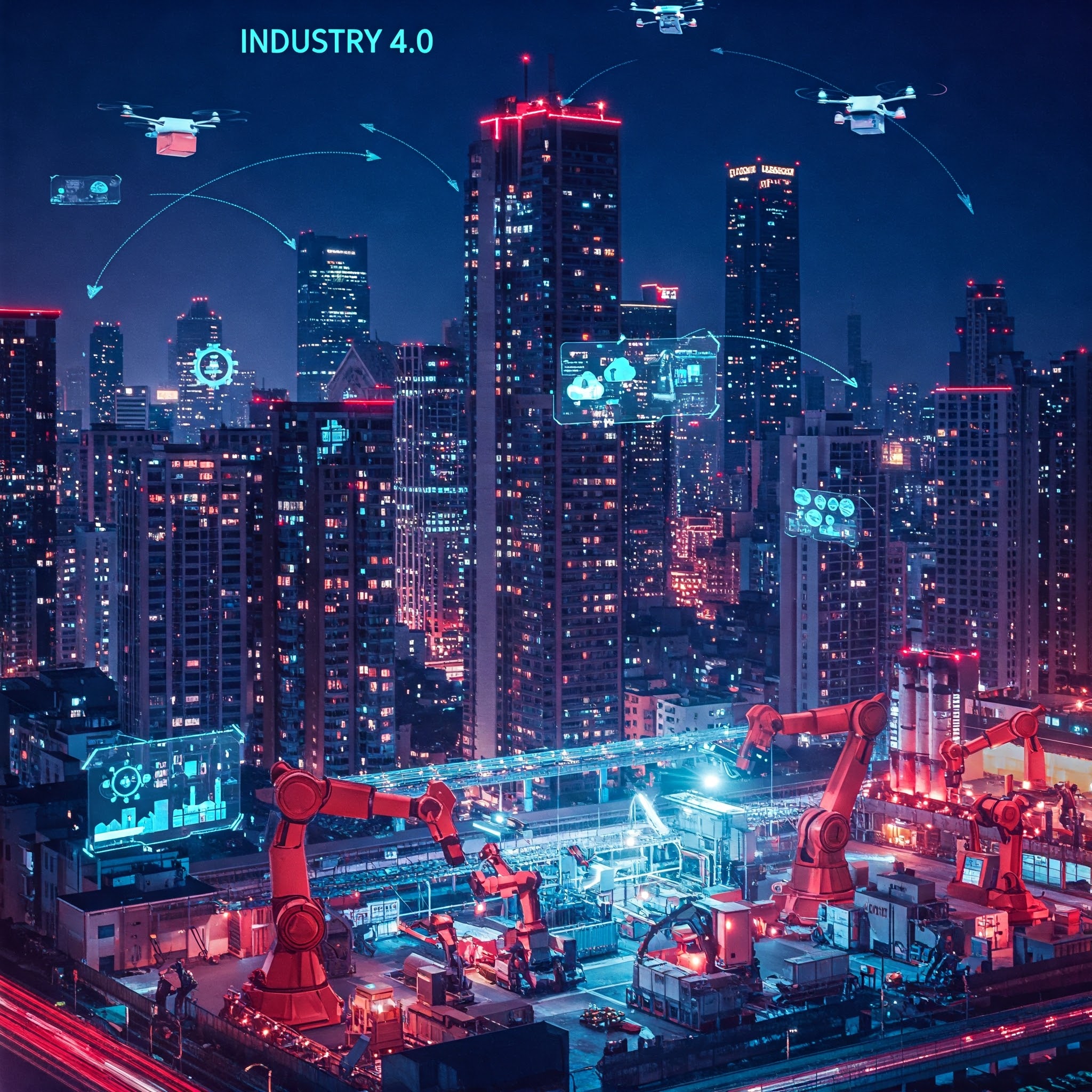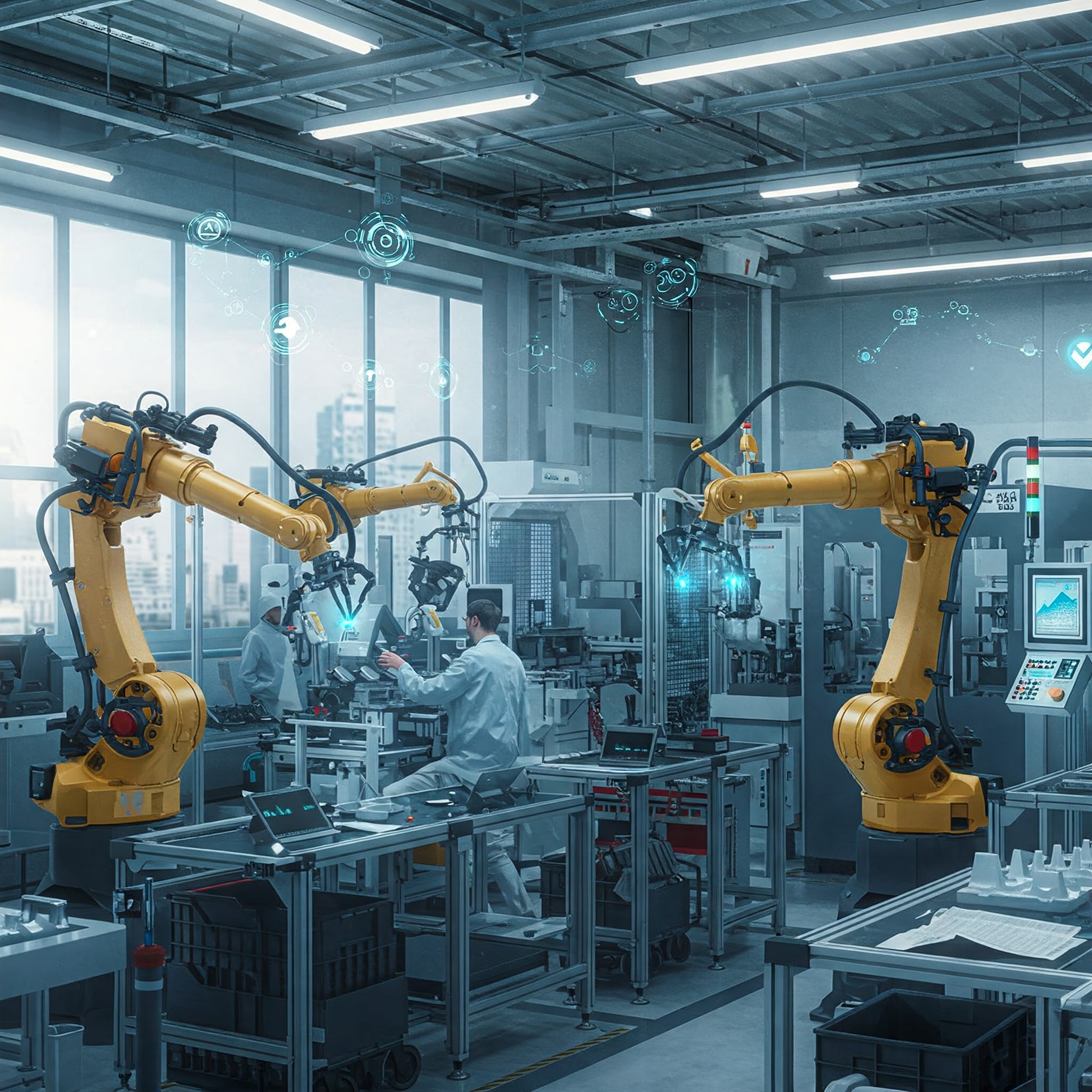Industry 4.0 describes a comprehensive transformation process resulting from the digitalization of the manufacturing and service sectors. It involves the integration of many advanced technologies such as artificial intelligence (AI), the Internet of Things (IoT), big data analytics, cyber-physical systems (CPS), cloud computing, robotics, and augmented reality. This transformation is a multi-layered paradigm with not only technical but also economic, social, legal, and ethical dimensions. Thanks to Industry 4.0, production processes have become more flexible, efficient, predictable, and customer-oriented. At the same time, this transformation is leading to fundamental changes in the competencies of the workforce, the understanding of governance, and the organization of economic structures.
History: Evolution from Industry 1.0 to 4.0
Industry 1.0: Mechanization (Late 18th - Early 19th century)
The first industrial revolution began with the spread of steam-powered machines in England in the late 18th century. Water and steam energy created a major transformation in sectors such as textiles, mining, and transportation, replacing production systems based on manual labor. During this period, workshop-type production was replaced by the factory system, which brought about urbanization and the emergence of the working class.
Industry 2.0: Electrification and Mass Production (Late 19th - Early 20th century)
The second industrial revolution, with the widespread use of electrical energy, enabled production processes to become more organized and efficient. Assembly lines were first applied systematically in Henry Ford's automobile factory. During this period, the division of labor was deepened, production was accelerated, and costs were reduced. At the same time, infrastructure projects, railways, and public transportation systems were built along with the development of the steel and chemical industries.
Industry 3.0: Automation and Information Technology (Mid-20th - Early 21st century)
The third industrial revolution was shaped by the integration of digital technologies into production. Microelectronics, computers, and software systems enabled automation in production processes. CNC machines, automation systems, PLCs, and robotic arms are the key elements of this period. During this period, production systems became more precise and flexible, and global supply chains were established through information technologies.
Industry 4.0: Digitalization and Intelligent Systems (2011 and Present)
The concept of Industry 4.0 was first introduced in 2011 at the Hannover Messe fair in Germany and was supported as a strategic national initiative by the German government that same year. At this stage, production systems are equipped with real-time data analytics, machine-to-machine communication (M2M), AI-driven decision-making, and autonomous management capabilities. Industry 4.0 is based on a system architecture that integrates physical production infrastructures with digital software systems. The new industrial model transforms not only manufacturing but also services, health, logistics, agriculture, and energy.

(Created by Artificial Intelligence)
Key Technologies of Industry 4.0
- Cyber-Physical Systems (CPS): Establishes an integrated and real-time relationship between physical production processes and digital systems.
- Internet of Things (IoT): All devices and machines are connected to each other to share data and manage them remotely.
- Artificial Intelligence (AI) and Machine Learning (ML): Allow decision-making mechanisms in production processes to become autonomous.
- Big Data and Analytics: By analyzing multidimensional data collected during the production process, performance improvement and predictive maintenance are achieved.
- Cloud and Edge Computing: Enables data to be processed and stored in centralized systems or near the device.
- Augmented Reality (AR) and Virtual Reality (VR): Support the user in training, maintenance, and assembly processes.
- Autonomous Robots: Robots that work without human intervention and adapt to their environment.
- Cyber Security: Aims to protect the entire digital infrastructure against threats.
Industry 4.0 Principles
- Interconnectedness: People, machines, sensors, and systems communicate continuously and in real time.
- Information Transparency: Data collected from all processes is analyzed and shared with all stakeholders of the system.
- Technical Assistance: The development of systems that assist people in decision-making processes and physical work.
- Autonomous Decision Making: The ability of systems to make certain decisions on their own without human intervention.
Industry 4.0 System Applicability
The applicability of Industry 4.0 systems varies across countries, sectors, and company sizes. Large-scale firms are generally able to make technology investments more easily, while SMEs are slower to digitalize. Sectoral differences also play a role: high-tech sectors such as automotive and electronics adapt faster than more traditional sectors such as textiles and food. Implementation success is directly related to workforce training, infrastructure investments, data management policies, and government support.

(Created by Artificial Intelligence)
Objectives of Industry 4.0
- Increase productivity
- Increasing competitiveness
- Implementing flexible production models
- Optimizing energy and resource use
- Creating new business models (e.g., digital platforms)
- Improving human-machine cooperation
- Accelerating data-driven decision-making processes
- Promote sustainability and environmental awareness
Advantages and Impacts of Industry 4.0
- Production Efficiency: Intelligent systems enable processes to produce more with fewer resources.
- Customer Satisfaction: Faster production of personalized products.
- Environmental Sustainability: Less waste, lower energy use.
- Labor Transformation: Increased demand for highly skilled labor.
- Global Competition: Companies can compete faster and more effectively in the global market.
- Product and Service Quality: More precise control of production processes leads to higher quality products and services.
Challenges and Risks
- High Costs: Installation and integration of new technologies require large investments.
- Data Security and Privacy: The constant exchange of data increases the risk of cyber attacks.
- Legal Regulatory Deficiencies: The legal infrastructure for digital systems is inadequate in most countries.
- Skilled Personnel Shortage: There is a shortage of technical personnel to manage digital systems.
- Digital Dependency and Attacks: System failures or cyber attacks can paralyze production.
- Ethical Issues: Issues such as the impact of automation on the workforce and the decision authority given to artificial intelligence are controversial.
- Adaptation Process: Especially for small businesses, the transition to these systems can be complex and time consuming.

(Created by Artificial Intelligence)
Future Perspective
The future of Industry 4.0 will be shaped not only by technological developments but also by how these technologies are integrated, regulated, and received by society. Developments such as quantum computing, biotechnology, 6G communication infrastructures and artificial general intelligence will deepen this process.


